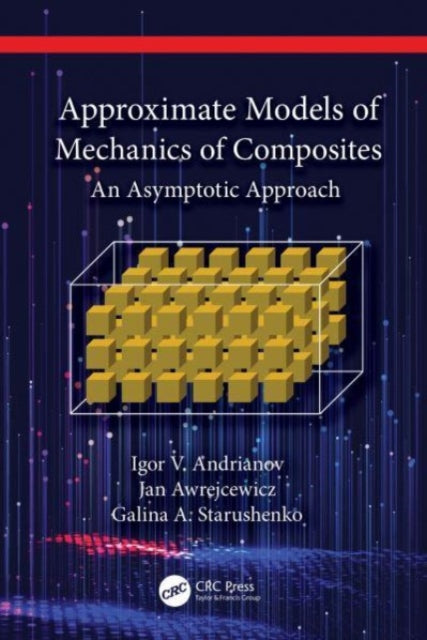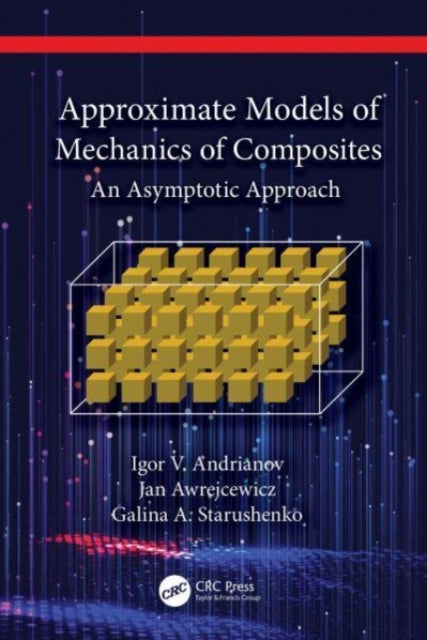Igor V.Andrianov,JanAwrejcewicz,Galina A.Starushenko
Approximate Models of Mechanics of Composites: An Asymptotic Approach
Approximate Models of Mechanics of Composites: An Asymptotic Approach
Earn [points_amount] when you buy this item.
YOU SAVE £3.84
- Condition: Brand new
- UK Delivery times: Usually arrives within 2 - 3 working days
- UK Shipping: Fee starts at £2.39. Subject to product weight & dimension
Bulk ordering. Want 15 or more copies? Get a personalised quote and bigger discounts. Learn more about bulk orders.
Couldn't load pickup availability
- More about Approximate Models of Mechanics of Composites: An Asymptotic Approach
The Maxwell equation is used to simulate the behavior of composite materials, and the COMSOL Multiphysics software is a powerful tool for analyzing and designing these materials. It provides accurate results by considering the complex physics of the composite structure, including the interactions between the fibers, matrix, and additives.
Format: Hardback
Length: 351 pages
Publication date: 20 June 2023
Publisher: Taylor & Francis Ltd
Here is the rephrased text:
Composite materials have gained significant attention in various industries due to their exceptional properties, such as high strength-to-weight ratios, durability, and corrosion resistance. However, the complex nature of these materials poses challenges in their analysis and design. To address these challenges, researchers have developed analytical solutions based on a three-phase model, which considers the microstructure, properties, and behavior of composite materials.
One of the key contributions of this research is the identification of computational models that can solve problems within all applications of composite materials. These models encompass a wide range of phenomena, including material modeling, finite element analysis, and computational fluid dynamics. By leveraging these models, researchers can accurately predict the behavior of composite structures under different loading conditions, such as thermal, mechanical, and electrical loads.
Another important aspect of this research is the construction of higher approximations of the Maxwell formula, which is a fundamental equation in electromagnetism. The Maxwell formula describes the behavior of electric and magnetic fields in composite materials, and its accurate representation is crucial for understanding the performance of these materials in various applications.
In addition to these analytical solutions, the research also proposes efficient analytical algorithms that ensure reliable computational analysis. These algorithms are designed to reduce the computational time and resources required for analyzing composite structures, making it possible to perform large-scale simulations and optimize design parameters.
Overall, this research has made significant strides in the analysis and design of composite materials. By developing analytical solutions based on a three-phase model, identifying computational models, constructing higher approximations of the Maxwell formula, and proposing efficient analytical algorithms, researchers have opened up new avenues for exploring the potential of composite materials in various industries.
Composite materials have gained significant attention in various industries due to their exceptional properties, such as high strength-to-weight ratios, durability, and corrosion resistance. However, the complex nature of these materials poses challenges in their analysis and design. To address these challenges, researchers have developed analytical solutions based on a three-phase model, which considers the microstructure, properties, and behavior of composite materials.
One of the key contributions of this research is the identification of computational models that can solve problems within all applications of composite materials. These models encompass a wide range of phenomena, including material modeling, finite element analysis, and computational fluid dynamics. By leveraging these models, researchers can accurately predict the behavior of composite structures under different loading conditions, such as thermal, mechanical, and electrical loads.
Another important aspect of this research is the construction of higher approximations of the Maxwell formula, which is a fundamental equation in electromagnetism. The Maxwell formula describes the behavior of electric and magnetic fields in composite materials, and its accurate representation is crucial for understanding the performance of these materials in various applications.
In addition to these analytical solutions, the research also proposes efficient analytical algorithms that ensure reliable computational analysis. These algorithms are designed to reduce the computational time and resources required for analyzing composite structures, making it possible to perform large-scale simulations and optimize design parameters.
Overall, this research has made significant strides in the analysis and design of composite materials. By developing analytical solutions based on a three-phase model, identifying computational models, constructing higher approximations of the Maxwell formula, and proposing efficient analytical algorithms, researchers have opened up new avenues for exploring the potential of composite materials in various industries.
Composite materials have gained significant attention in various industries due to their exceptional properties, such as high strength-to-weight ratios, durability, and corrosion resistance. However, the complex nature of these materials poses challenges in their analysis and design. To address these challenges, researchers have developed analytical solutions based on a three-phase model, which considers the microstructure, properties, and behavior of composite materials.
One of the key contributions of this research is the identification of computational models that can solve problems within all applications of composite materials. These models encompass a wide range of phenomena, including material modeling, finite element analysis, and computational fluid dynamics. By leveraging these models, researchers can accurately predict the behavior of composite structures under different loading conditions, such as thermal, mechanical, and electrical loads.
Another important aspect of this research is the construction of higher approximations of the Maxwell formula, which is a fundamental equation in electromagnetism. The Maxwell formula describes the behavior of electric and magnetic fields in composite materials, and its accurate representation is crucial for understanding the performance of these materials in various applications.
In addition to these analytical solutions, the research also proposes efficient analytical algorithms that ensure reliable computational analysis. These algorithms are designed to reduce the computational time and resources required for analyzing composite structures, making it possible to perform large-scale simulations and optimize design parameters.
Overall, this research has made significant strides in the analysis and design of composite materials. By developing analytical solutions based on a three-phase model, identifying computational models, constructing higher approximations of the Maxwell formula, and proposing efficient analytical algorithms, researchers have opened up new avenues for exploring the potential of composite materials in various industries.
Composite materials have gained significant attention in various industries due to their exceptional properties, such as high strength-to-weight ratios, durability, and corrosion resistance. However, the complex nature of these materials poses challenges in their analysis and design. To address these challenges, researchers have developed analytical solutions based on a three-phase model, which considers the microstructure, properties, and behavior of composite materials.
One of the key contributions of this research is the identification of computational models that can solve problems within all applications of composite materials. These models encompass a wide range of phenomena, including material modeling, finite element analysis, and computational fluid dynamics. By leveraging these models, researchers can accurately predict the behavior of composite structures under different loading conditions, such as thermal, mechanical, and electrical loads.
Another important aspect of this research is the construction of higher approximations of the Maxwell formula, which is a fundamental equation in electromagnetism. The Maxwell formula describes the behavior of electric and magnetic fields in composite materials, and its accurate representation is crucial for understanding the performance of these materials in various applications.
In addition to these analytical solutions, the research also proposes efficient analytical algorithms that ensure reliable computational analysis. These algorithms are designed to reduce the computational time and resources required for analyzing composite structures, making it possible to perform large-scale simulations and optimize design parameters.
Overall, this research has made significant strides in the analysis and design of composite materials. By developing analytical solutions based on a three-phase model, identifying computational models, constructing higher approximations of the Maxwell formula, and proposing efficient analytical algorithms, researchers have opened up new avenues for exploring the potential of composite materials in various industries.
Weight: 840g
Dimension: 234 x 156 (mm)
ISBN-13: 9781032488301
This item can be found in:
UK and International shipping information
UK and International shipping information
UK Delivery and returns information:
- Delivery within 2 - 3 days when ordering in the UK.
- Shipping fee for UK customers from £2.39. Fully tracked shipping service available.
- Returns policy: Return within 30 days of receipt for full refund.
International deliveries:
Shulph Ink now ships to Australia, Belgium, Canada, France, Germany, Ireland, Italy, India, Luxembourg Saudi Arabia, Singapore, Spain, Netherlands, New Zealand, United Arab Emirates, United States of America.
- Delivery times: within 5 - 10 days for international orders.
- Shipping fee: charges vary for overseas orders. Only tracked services are available for most international orders. Some countries have untracked shipping options.
- Customs charges: If ordering to addresses outside the United Kingdom, you may or may not incur additional customs and duties fees during local delivery.


 Excellent
Excellent